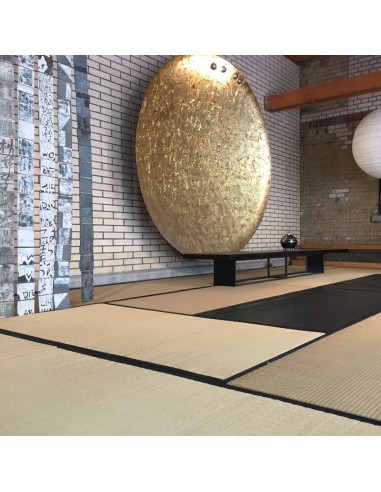Tatami Standard
Lieferzeit ca. 7 - 10 Arbeitstage
Sato Tatami are traditional Japanese rice straw mats, manufactured in Taiwan according to the Japanese guidelines JIS 5901 regarding material and manufacturing process. These guidelines prohibit the use of pesticides. Standard version with Beri black. Stock in Switzerland, issued by Sato.
Read more about the tatami > in this article.
With tatami, you can create a natural and Japanese-style atmosphere for sleeping, working or meditating. With little financial and material investment, you can create your own personal European-Japanese sleeping environment, a zen room or simple meditation corner, a calming workspace, a place to relax and retreat, or perhaps a reminder of a wonderful time in Japan. Tatami are timeless and minimalist. Your companions through life. Slow Living.
Care: Sato tatamis can be laid directly on the floor of the room, whether on stone, parquet or carpet, with or without underfloor heating. Thanks to their dimensional accuracy, the tatamis also fit into all Sato bed frames, supported by the rigid grates. Occasionally wipe with a slightly (!) damp cotton cloth or vacuum in the direction of the woven bulrush. Do not walk on with shoes. Do not place heavy objects on them. When moving objects, do not push them, but lift them.
More information: Traditional Japanese tatami consists of several layers of tightly quilted rice straw, covered on the upper side with a mat made of woven igusa bamboo grass. The underside is covered with special kraft paper. The sides of the tatami are bordered with black textile tape called Beri. The height is about 5.4 cm.
In traditional Japanese houses, tatami is the floor covering. The size of the rooms is determined by the number of tatami mats, with the architecture being aligned with the traditional tatami dimensions, which differ from region to region. Tatami is only entered with socks, never with shoes.
The surface, which is green at first, quickly turns yellow naturally due to exposure to light. Tatamis can be used for a very long time. Old tatamis do not look shabby, but convey natural charm, telling the story of all its users, the inhabitants of the rooms.
Sato tatami is manufactured in Taiwan in accordance with the Japanese Industrial Standard 5901. Unlike Chinese tatami, it is manufactured without the use of pesticides. It is sterilised by being heat-treated twice. Before manufacturing, the raw material is stored at 80 degrees Celsius for six hours, and then again immediately after production. Japanese guidelines also prescribe the quality of the individual raw materials, from the rice straw (including its origin), to the stitching and binding threads used, the paper on the underside, and the reed grass for the sewn-on goza mat on the upper side. There are also specifications for the evenness and strength of the straw core, as well as for the dimensional accuracy.
The latter is extremely important for the problem-free and appropriate laying out in the specified basic dimensions of Japanese architecture, but also in the conditions in our western rooms and in particular western bed frames. Thanks to the strict quality requirements, Japanese tatami, and thus also Sato's tatami, achieve a very long lifespan when treated properly. It is not surprising that about 90% of the production of our manufacturer, a family business in its 3rd generation, goes to tatami dealers in Japan.
Weight: for size 90 x 200 cm approx. 30 kg. Japanese tatami size max. 90 x 210 cm. Special sizes on request.
















